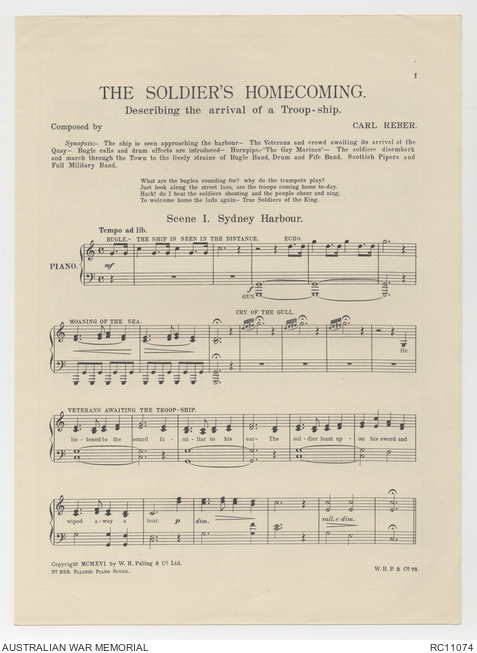| Accession Number | RC11074 |
|---|---|
| Collection number | Sheet Music Collection 589 |
| Collection type | Published Collection |
| Record type | Item |
| Item count | 1 |
| Measurement | Overall: 36 cm x 26 cm |
| Object type | Sheet Music |
| Maker |
Reber, Carl |
| Place made | Australia: New South Wales, Sydney |
| Date made | 1916 |
| Conflict |
First World War, 1914-1918 |
| Copying Provisions | Digital format and content protected by copyright. |
[Sheet music] The soldier's homecoming : describing the arrival of a troopship








Sheet music for the instrumental piece titled 'The Soldier's Homecoming', with music composed by Carl Reber. This copy was published by W H Paling and Co, Sydney in 1916 and printed in England. Copies of the music sold for 2/- and allocated number 223 in Paling's Pianoforte Series.
The cover features a pale blue background with the title of the song printed in bold, capital letters above a decorative sign containing further descriptive information about the work, including the name of the composer, genre and instrument. This copy of the music also includes the first few bars of the songs titled 'Mountain mists', 'Thoughts', 'An Autumn reverie' and 'Falling stars' by Gordon French, and 'Summer Showers', 'Sweet recollections', 'Tete a tete' and 'Pirouette' by Clarence Elkin.
This piano solo is described on the cover as a descriptive fantasia of the arrival of a troopship. Carl Reber composed descriptive pieces for piano which have been described as falling within the salon music genre. Fantasias form a sub-genre of this category and were popular during the nineteenth century. Descriptive fantasia are a type of musical composition depicting an event with music that also incorporates tunes that many people know or recognise. Works, such as this one, were popular with pianists for parlour performances, and also provided opportunities for their audience to vocally join in during the snippets of familiar songs.
This piece of music is representative of sentiments experienced during the First World War by both soldiers and loved ones remaining in Australia during this period. A synopsis at the beginning of the piece reads: "The ship is seen approaching the harbour- The Veterans and crowd awaiting its arrival at the Quay- Bugle calls and drum effects are introduced- Hornpipe- 'The Gay Marines'- The Soldiers disembark and march through the Town to the lively strains of Bugle Band, Drum and Fife Band, Scottish Pipers and Full Military Band." The music describes the arrival of a troopship at Circular Quay, Sydney, and features two scenes to illustrate the event.
The first scene is set at Sydney Harbour, with the troopship spotted in the distance by veterans and cheering crowds. This section of the work features passages from Army bugle calls like 'Orders' and 'Fall In!'. The sound of drums and coo-ees are also incorporated into the musical portrayal of the scene together with excerpts fromas well as the popular song 'The Song of Australia'.
The second scene describes the disembarking troops and their subsequent march through the city to the strains of drums, fifes, bagpipes and bugle bands with snippets from 'A Highland Lass My Love was born', 'Red, White and Blue' and finishing with 'Rule Britannia'.
Carl Reber was known for his descriptive pieces and wrote a series of these works under the title "Life Pictures". These included the musical work titled 'Soldier's Life', amongst others. His most famous piece was titled 'Remembrance', and most of his music was published in London between 1908 and 1916. The National Library of Australia has the largest collection of his music in the world - with 17 pieces in total. It is believed that the name 'Carl Reber' is a pseudonym in some circles. There is a copy of this piece held by the National Library of Australia with the name 'Cyril Stafford' as the composer on the front cover. Some of Reber's other works include: 'The Slave's Dream', 'Ellan Vannin', 'The Fire Brigade', 'The Emigrant Ship', 'Country Scenes', 'A Summer Song', 'An evening meditation' and 'Autumn Fancies'. Another series of musical works that he produced were based on popular airs and was titled 'Good Company'.
Towards the bottom of this page is a sound recording of this sheet music, or a parody, that was created as part of the Music and the First World War project. More information about this recording, including names of the performers, can be found on the catalogue record for the sound recording. A link to the catalogue record for the sound recording can be found at the bottom of this page, under the heading ‘Related objects’ where it can be identified with the prefix [sound recording].
- Download PDF document of [Sheet music] The soldier's homecoming : describing the arrival of a troopship (file)
-
Listen to
[Sheet music] The soldier's homecoming : describing the arrival of a troopship